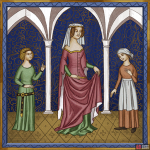Text
In the medieval patriarchal society, the male was the head of the family, and a woman’s role was defined by her relationship to him—daughter, sister, wife, mother, or widow. Girls had a short childhood, reaching adulthood between the ages of 12 and 15 according to municipal documents, while boys reached adulthood at 15 years old.
Women were primarily expected to take care of the household, home, and family, while men spent most of their time engaged in crafts or trade. Only a widow could obtain permission to run a business or practice a craft with the help of journeymen.
For wealthier women, domestic activities included mainly embroidery, cleaning, child care, shopping, or teaching musical instruments. In the countryside, women worked in the fields or pastures, engaged in beekeeping, weaving, spinning, food preparation, knitting, or sewing. Women were also employed in some professions, such as midwives, servants, innkeepers, bathhouse attendants, or moneylenders.
Women rarely left their homes unnecessarily. The rules for outings were defined by the relevant social class. While townswomen and noblewomen could move outside the home only accompanied by their husbands or servants, the wives of craftsmen, traders, and farmers could go out alone.
The ideal of beauty in the high Middle Ages was a thin, pale woman with long blonde hair, small round breasts, not too wide hips, and a narrow waist, with an emphasis on health and fertility. Pregnancy was very common from the onset of sexual maturity in women. Births were complicated and subsequent care inadequate, making the risk of death during childbirth high. Miscarriages were also frequent.
Unmarried daughters or single mothers brought disgrace to their families and were even marginalized in society. Girls did not inherit trades; parents had to accumulate a dowry and pay it to the groom.


No Comments